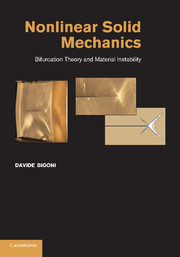Book contents
- Frontmatter
- Contents
- Preface
- Foreword by Giulio Maier
- 1 Introduction
- 2 Elements of tensor algebra and analysis
- 3 Solid mechanics at finite strains
- 4 Isotropic non-linear hyperelasticity
- 5 Solutions of simple problems in finitely deformed non-linear elastic solids
- 6 Constitutive equations and anisotropic elasticity
- 7 Yield functions with emphasis on pressure sensitivity
- 8 Elastoplastic constitutive equations
- 9 Moving discontinuities and boundary value problems
- 10 Global conditions of uniqueness and stability
- 11 Local conditions for uniqueness and stability
- 12 Incremental bifurcation of elastic solids
- 13 Applications of local and global uniqueness and stability criteria to non-associative elastoplasticity
- 14 Wave propagation, stability and bifurcation
- 15 Post-critical behaviour and multiple shear band formation
- 16 A perturbative approach to material instability
- References
- Index
- Plate section
12 - Incremental bifurcation of elastic solids
Published online by Cambridge University Press: 05 August 2012
- Frontmatter
- Contents
- Preface
- Foreword by Giulio Maier
- 1 Introduction
- 2 Elements of tensor algebra and analysis
- 3 Solid mechanics at finite strains
- 4 Isotropic non-linear hyperelasticity
- 5 Solutions of simple problems in finitely deformed non-linear elastic solids
- 6 Constitutive equations and anisotropic elasticity
- 7 Yield functions with emphasis on pressure sensitivity
- 8 Elastoplastic constitutive equations
- 9 Moving discontinuities and boundary value problems
- 10 Global conditions of uniqueness and stability
- 11 Local conditions for uniqueness and stability
- 12 Incremental bifurcation of elastic solids
- 13 Applications of local and global uniqueness and stability criteria to non-associative elastoplasticity
- 14 Wave propagation, stability and bifurcation
- 15 Post-critical behaviour and multiple shear band formation
- 16 A perturbative approach to material instability
- References
- Index
- Plate section
Summary
Several bifurcation problems for elastic incompressible solids, deformed in plane or axi-symmetric strain, are set and solved. In particular, an elastic block deformed under plane strain and a cylinder with circular cross section are considered, the former loaded biaxially and the latter uniaxially. Surface instabilities (at a free surface and at a surface dividing two elastic half spaces of different mechanical properties) and shear banding are also considered. The former is shown to represent an accumulation point for bifurcation stresses, and the latter is shown to correspond to an extreme form of instability. Finally, incremental bifurcations are analysed emerging from an inhomogeneous stress state, namely, finite plane strain bending of an incompressible elastic layer obeying neo-Hookean constitutive law.
In Chapters 10 and 11we introduced sufficient conditions for uniqueness and stability of elastic and elastoplastic solids. In engineering applications the usual problem is to find bifurcation loads and modes during continued deformation of a solid body subjected to a prescribed loading program.
The purpose of this Chapter is to formulate and solve several bifurcation problems for incompressible materials deformed incrementally in plane strain or axisymmetrically. In particular, the following five bifurcation problems are addressed: (1) a homogeneously stressed half space, loaded parallel to the free surface, (2) two homogeneously stressed elastic half spaces, loaded parallel to the surface separating them, (3) a homogeneously stressed block loaded parallel to two edges (a problem that will be generalized to include bifurcations of a layer on an elastic foundation, a layer on an elastic half space and a generic stack of layers), (4) a cylinder loaded under uniaxial compression parallel to its axis, and (5) an elastic layer subject to finite bending.
- Type
- Chapter
- Information
- Nonlinear Solid MechanicsBifurcation Theory and Material Instability, pp. 338 - 384Publisher: Cambridge University PressPrint publication year: 2012



